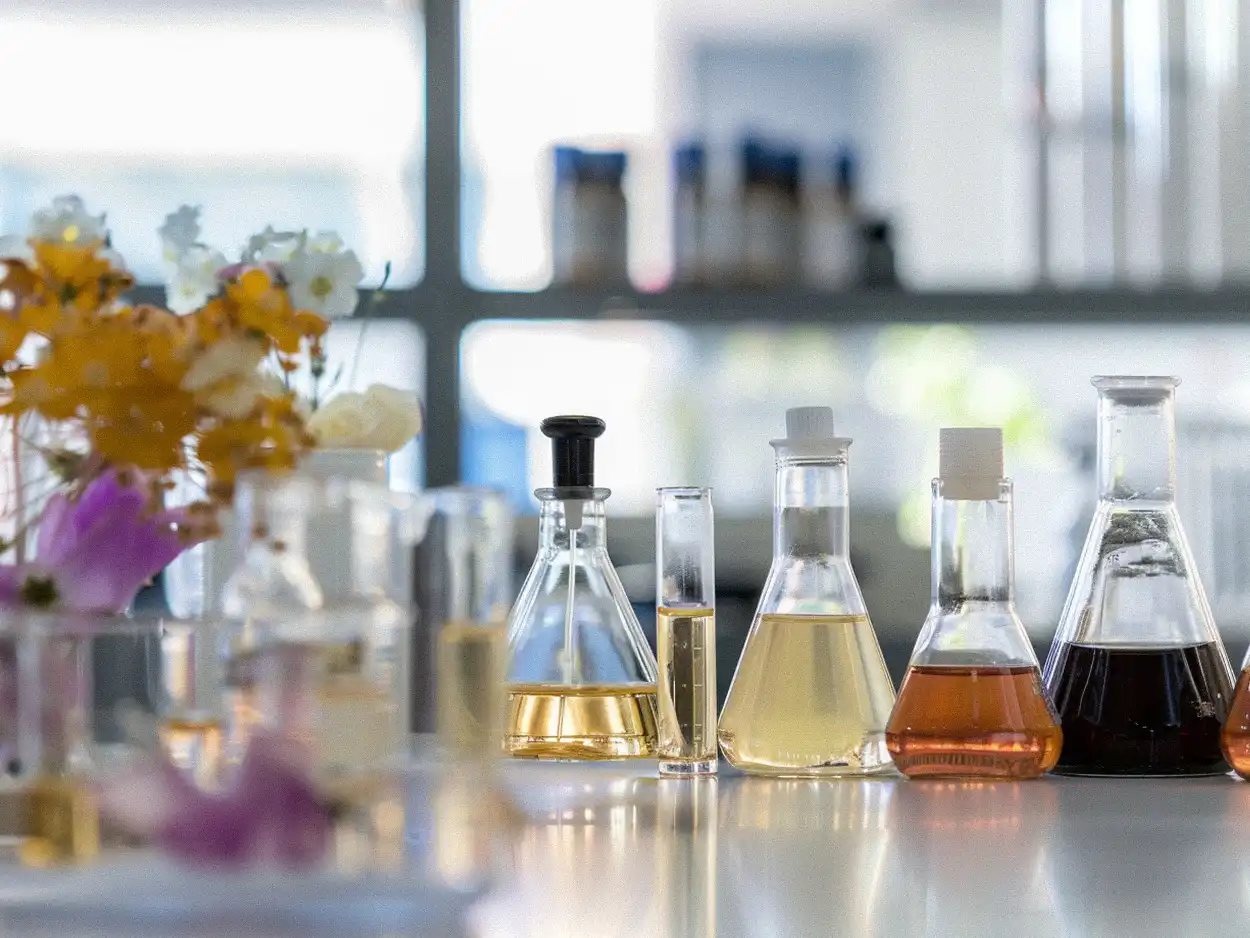The world of perfumery is a captivating blend of art and science, where scents are crafted to evoke emotions and memories. At the heart of this aromatic industry lies a fascinating debate: synthetic versus natural ingredients.
This discussion has been ongoing for decades, with perfumers, consumers, and industry experts weighing in on the merits and drawbacks of each. As the fragrance world continues to evolve, understanding the role of both synthetic and natural ingredients becomes crucial for anyone interested in the art of perfume creation.
Natural Ingredients in Perfumery
Natural ingredients have been the cornerstone of perfumery since ancient times. These aromatic treasures are derived from various sources in the natural world, including flowers, fruits, woods, resins, and animal products.
The process of extracting these scents can be as intricate as the fragrances themselves. Methods range from simple expression, where oils are physically pressed from plant materials, to more complex techniques like steam distillation and solvent extraction.
One of the most prized natural ingredients in perfumery is rose oil. To produce just one kilogram of this precious essence, perfumers need to process around 4,000 kilograms of rose petals. This labor-intensive process contributes to the high cost of natural ingredients, but many argue that the result is worth it.
Natural ingredients are often celebrated for their complexity and depth. A single natural oil can contain hundreds of different molecular components, creating a rich, multifaceted scent profile that’s difficult to replicate synthetically. For example, jasmine absolute contains over 300 distinct chemical compounds, each contributing to its intoxicating aroma.
Perfumers who favor natural ingredients often speak of their ‘life force’ or ‘energy’. These qualities are hard to quantify scientifically, but many believe that natural ingredients bring a vibrancy and authenticity to fragrances that synthetic alternatives struggle to match.
However, working with natural ingredients isn’t without its challenges. One of the biggest hurdles is consistency. Natural materials can vary significantly based on factors like climate, soil conditions, and harvest time. This variability can be a headache for perfumers striving for a consistent product.
Availability is another concern. Many natural ingredients are seasonal, and some are becoming increasingly scarce due to overharvesting or climate change. The Indian sandalwood tree, for instance, has been so heavily exploited that it’s now a protected species, forcing perfumers to seek alternatives.
Ethical considerations also come into play when using natural ingredients. Some traditional animal-derived ingredients, such as musk from musk deer or ambergris from sperm whales, have fallen out of favor due to animal welfare concerns. This has led to the development of synthetic alternatives and the use of plant-based substitutes.
Despite these challenges, natural ingredients continue to hold a special place in perfumery. Their complex scent profiles, rich history, and connection to the natural world ensure that they remain a vital part of the perfumer’s palette, even as synthetic options expand.
Synthetic Ingredients in Perfumery
Synthetic ingredients have revolutionized the perfume industry since their introduction in the late 19th century. These man-made molecules are created in laboratories, designed to mimic natural scents or to produce entirely new fragrances that don’t exist in nature.
The development of synthetic ingredients began in earnest with the creation of coumarin in 1868, a compound with a sweet, hay-like scent. This breakthrough opened up a world of possibilities for perfumers, allowing them to create scents that were previously impossible or impractical to produce.
Today, synthetic ingredients form the backbone of modern perfumery. They offer perfumers a vast array of scent options, from exact replicas of natural ingredients to completely novel aromas. For instance, synthetic musks provide the lasting base notes in many popular fragrances, while molecules like Iso E Super create subtle, woody scents that are hard to pinpoint but incredibly appealing.
One of the key advantages of synthetic ingredients is their consistency. Unlike natural materials that can vary from batch to batch, synthetic molecules are identical every time they’re produced. This consistency is crucial for large-scale perfume production, ensuring that a fragrance smells the same whether it’s made in New York or New Delhi.
Synthetic ingredients also tend to be more stable than their natural counterparts. They’re less likely to degrade or change over time, which means fragrances can maintain their intended scent profile for longer periods. This stability is particularly important for top notes – the first scents you smell when applying a perfume – which are often composed of volatile natural materials.
Cost-effectiveness is another significant benefit of synthetic ingredients. While some synthetic molecules can be expensive to develop initially, they’re often much cheaper to produce at scale than rare natural ingredients. This cost advantage allows perfumers to create complex, high-quality fragrances at more accessible price points.
Synthetic ingredients have also played a crucial role in preserving endangered species and ecosystems. By providing alternatives to rare or unsustainable natural ingredients, they’ve helped reduce the pressure on over-harvested plants and animals. Synthetic civet, for example, has largely replaced the natural musk extracted from civet cats, protecting these animals from exploitation.
Despite these advantages, synthetic ingredients often face misconceptions and skepticism from consumers. There’s a common belief that ‘natural’ always means ‘better’ or ‘safer’, which isn’t necessarily true in the world of perfumery. Many synthetic ingredients undergo rigorous safety testing and are often less likely to cause allergic reactions than some natural materials.
Another misconception is that synthetic fragrances are inherently ‘cheap’ or ‘fake’. In reality, many of the world’s most expensive and highly regarded perfumes use a combination of natural and synthetic ingredients. The artistry lies in how these ingredients are combined, not in their origin.
Perfumers often speak of synthetic ingredients as tools that expand their creative palette. These molecules allow them to recreate scents from nature that are too delicate or fleeting to capture traditionally, like the smell of fresh air after rain or the scent of a particular flower that doesn’t yield an essential oil.
As technology advances, the line between natural and synthetic is becoming increasingly blurred. Some companies are now using biotechnology to produce synthetic versions of natural molecules, creating ingredients that are chemically identical to their natural counterparts but produced in a lab. This approach combines the consistency and sustainability of synthetics with the complex scent profiles of natural ingredients.
Consumer Perceptions
Consumer perceptions significantly influence the synthetic versus natural ingredient debate in perfumery. These views are often shaped by marketing, cultural trends, and personal beliefs about health and the environment.
Historically, there’s been a strong preference for natural ingredients among consumers. Many associate natural fragrances with luxury, authenticity, and safety, often perceiving them as more complex and sophisticated than synthetic alternatives. Marketing has reinforced these perceptions, with many brands highlighting their use of natural ingredients to create an aura of purity and exclusivity.
However, attitudes towards synthetic ingredients are evolving. As consumers become more educated about the perfume industry, there’s growing appreciation for the artistry and innovation behind synthetic fragrances. Some consumers now value synthetic ingredients for their consistency, longevity, and unique scent profiles.
The rise of “clean” and “transparent” beauty movements has also influenced perceptions. While these initially favored natural ingredients, there’s an increasing emphasis on safety and sustainability rather than ingredient origin. This shift has led some consumers to accept synthetic ingredients that have been proven safe and environmentally friendly.
Despite these changes, misconceptions about synthetic ingredients persist. Many still associate “synthetic” with “artificial” or “chemical,” terms that carry negative connotations. Educating consumers about the safety, sustainability, and creative potential of synthetic ingredients remains a challenge for the perfume industry.
Conclusion
The debate between synthetic and natural ingredients in perfumery is nuanced, with both types playing crucial roles in modern fragrance creation. So, should consumers be concerned about synthetic ingredients in their perfumes? Not necessarily.
Synthetic ingredients have proven to be safe, versatile, and often more sustainable than their natural counterparts. They’ve expanded the artistic possibilities of fragrance creation and undergone rigorous safety testing. From an environmental perspective, synthetics often require less land and water to produce, reducing pressure on potentially endangered plant species.
Cost is another important factor. Natural ingredients like oud can be extraordinarily expensive, making them impractical for many fragrances and potentially driving over-harvesting. Synthetic alternatives provide extremely similar scent profiles at a fraction of the cost, making them more accessible and sustainable.
However, natural ingredients still have their place, offering complexity and a connection to the natural world. Many modern perfumers use a balanced combination of both natural and synthetic ingredients.

